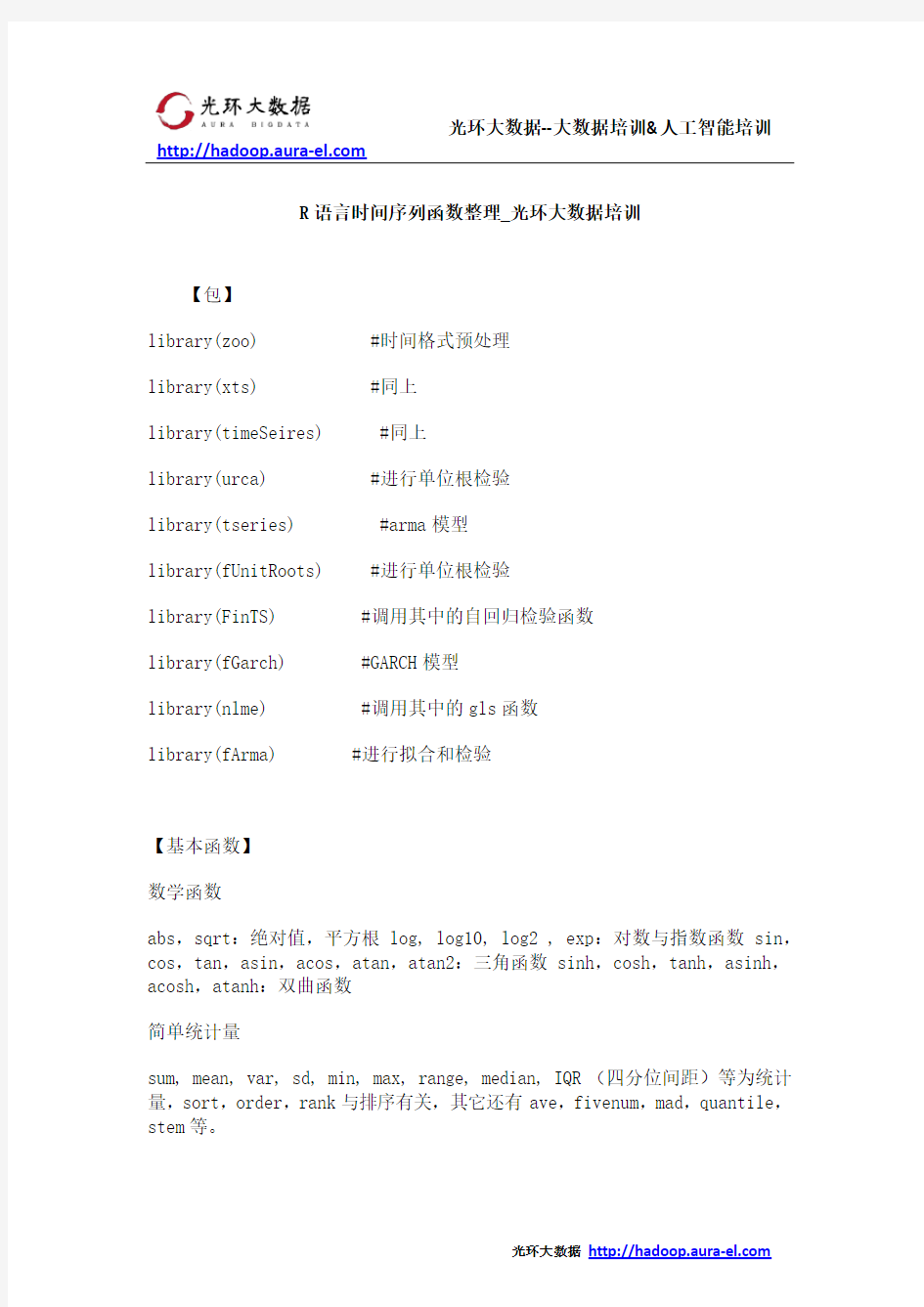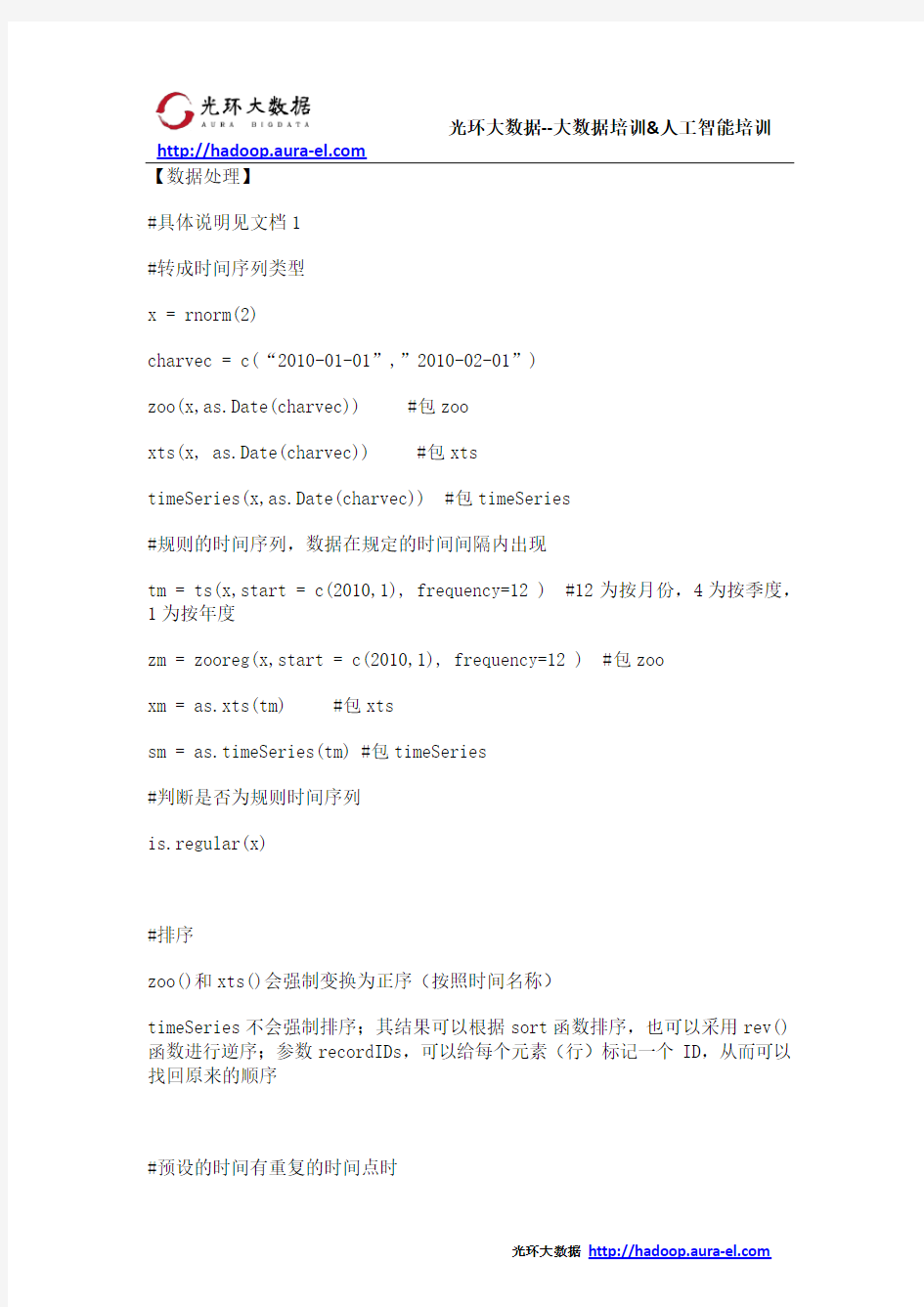R语言时间序列函数整理_光环大数据培训


https://www.360docs.net/doc/5211536266.html,
R语言时间序列函数整理_光环大数据培训
【包】
library(zoo) #时间格式预处理
library(xts) #同上
library(timeSeires) #同上
library(urca) #进行单位根检验
library(tseries) #arma模型
library(fUnitRoots) #进行单位根检验
library(FinTS) #调用其中的自回归检验函数
library(fGarch) #GARCH模型
library(nlme) #调用其中的gls函数
library(fArma) #进行拟合和检验
【基本函数】
数学函数
abs,sqrt:绝对值,平方根 log, log10, log2 , exp:对数与指数函数 sin,cos,tan,asin,acos,atan,atan2:三角函数 sinh,cosh,tanh,asinh,acosh,atanh:双曲函数
简单统计量
sum, mean, var, sd, min, max, range, median, IQR(四分位间距)等为统计量,sort,order,rank与排序有关,其它还有ave,fivenum,mad,quantile,stem等。
https://www.360docs.net/doc/5211536266.html,
#具体说明见文档1
#转成时间序列类型
x = rnorm(2)
charvec = c(“2010-01-01”,”2010-02-01”)
zoo(x,as.Date(charvec)) #包zoo
xts(x, as.Date(charvec)) #包xts
timeSeries(x,as.Date(charvec)) #包timeSeries
#规则的时间序列,数据在规定的时间间隔内出现
tm = ts(x,start = c(2010,1), frequency=12 ) #12为按月份,4为按季度,1为按年度
zm = zooreg(x,start = c(2010,1), frequency=12 ) #包zoo
xm = as.xts(tm) #包xts
sm = as.timeSeries(tm) #包timeSeries
#判断是否为规则时间序列
is.regular(x)
#排序
zoo()和xts()会强制变换为正序(按照时间名称)
timeSeries不会强制排序;其结果可以根据sort函数排序,也可以采用rev()函数进行逆序;参数recordIDs,可以给每个元素(行)标记一个ID,从而可以找回原来的顺序
#预设的时间有重复的时间点时
https://www.360docs.net/doc/5211536266.html,
xts按照升序排列
timeSeries把重复部分放置在尾部;
#行合并和列合并
#都是按照列名进行合并,列名不同的部分用NA代替
cbind()
rbind()
merge() 列合并
#取子集
xts()默认将向量做成了矩阵;其他与常规向量或者矩阵没有差别
#缺失值处理
na.omit(x)
x[is.na(x)] = 0
x[is.na(x)] = mean(x,na.rm=TRUE)
x[is.na(x)] = median(x,na.rm=TRUE)
na.approx(x) #对缺失值进行线性插值
na.spline(x) #对缺失值进行样条插值
na.locf(x) #末次观测值结转法
na.trim(x, sides=”left” ) #去掉最后一个缺失值
https://www.360docs.net/doc/5211536266.html,
na.omit(x, “ir” ) #去掉首末位置的缺失值
na.omit(x, “iz” ) #用替换首末位置的缺失值
na.omit(x, “ie” ) #对首末位置的缺失值进行插值
na.omit(x, method=“ie”, interp= c(“before”,”linear”,”after”) ) #可以选择插值方法,before末次观测值法,after下次观测结转法
as.contiguous(x) #返回x中最长的连续无缺失值的序列片段,如果有两个等长的序列片段,则返回第一个。
#时间序列数据的显示
#zoo和xts都只能按照原来的格式显示,timeSeries可以设置显示格式
print(x, format= “%m/%d/%y %H:%M”) #%m表示月,%d表示天,%y表示年,%H 表示时,%M表示分钟,%A表示星期,%j表示天的序号
#timeSeries也可以按照ts的格式显示
print(x, style=”ts”)
print(x, style=”ts”, by=”quarter”)
【图形展示】
plot.zoo(x)
plot.xts(x)
plot.zoo(x, plot.type=”single”) #支持多个时间序列数据在一个图中展示
plot(x, plot.type=”single”) #支持多个时间序列数据在一个图中展示,仅对xts不行
https://www.360docs.net/doc/5211536266.html,
【基本统计运算】
1、自相关系数、偏自相关系数等
例题2.1
d=scan(“sha.csv”)
sha=ts(d,start=1964,freq=1)
plot.ts(sha) #绘制时序图
acf(sha,22) #绘制自相关图,滞后期数22
pacf(sha,22) #绘制偏自相关图,滞后期数22
corr=acf(sha,22) #保存相关系数
cov=acf(sha,22,type = “covariance”) #保存协方差
2、同时绘制两组数据的时序图
d=read.csv(“double.csv”,header=F)
double=ts(d,start=1964,freq=1)
plot(double, plot.type = “multiple”) #两组数据两个图
plot(double, plot.type = “single”) #两组数据一个图
plot(double, plot.type = “single”,col=c(“red”,”green”),lty=c(1,2)) #设置每组数据图的颜色、曲线类型)
3、纯随机性检验
例题2.3续
d=scan(“temp.csv”)
https://www.360docs.net/doc/5211536266.html,
Box.test(temp, type=”Ljung-Box”,lag=6)
4、差分运算和滞后运算
diff
lag
5、模拟ARIMA模型的结果
arima.sim(n = 100, list(ar = 0.8))
plot.ts(arima.sim(n = 100, list(ar = 0.8))) #会随机产生一个包含100个随机数的时序图
plot.ts(arima.sim(n = 100, list(ar = -1.1))) #非平稳,无法得到时序图。
plot.ts(arima.sim(n = 100, list(ar = c(1,-0.5))))
plot.ts(arima.sim(n = 100, list(ar = c(1,0.5))))
arima.sim(n = 1000, list(ar = 0.5, ma = -0.8))
acf(arima.sim(n = 1000, list(ar = 0.5, ma = -0.8)),20)
pacf(arima.sim(n = 1000, list(ar = 0.5, ma = -0.8)),20)
【单位根检验】
#方法1
b=ts(read.csv(“6_1.csv”,header=T))
x=b[,1]
y=b[,1]
https://www.360docs.net/doc/5211536266.html,
#方法2:单位根检验更好的函数,加了画图的功能
library(fUnitRoots)
urdfTest(x)
#方法3:ADF检验的一个自编函数
library(urca)
#…
ur.df.01=function(x,lags=8){
#将三种ADF检验形式汇总的函数(结果和EVIEWS不一致)
res=matrix(0,5,3)
colnames(res)=c(“无”,”含常数项”,”含常数项和趋势项”) rownames(res)=c(“tau统计量”,”1%临界值”,”5%临界值”, “10%临界值”,”是否稳定(1/0)”)
types=c(“none”,”drift”,”trend”)
for(i in 1:3){
x.adf=ur.df(x,type=types[i],lags=lags,selectlags=”AIC”) x.adf.1=x.adf@teststat #统计量
x.adf.2=x.adf@cval #临界值
res[1,i] =x.adf.1[1]
res[2:4,i]=x.adf.2[1,]
res[5,i]=if( abs(res[1,i]) > abs(res[3,i]) ) 1 else 0
}
https://www.360docs.net/doc/5211536266.html,
}
#…
ur.df.01(x) #对原序列进行判断
【一般的ARIMA模型】
d=scan(“a1.5.txt”) #导入数据
prop=ts(d,start=1950,freq=1) #转化为时间序列数据
plot(prop) #作时序图
acf(prop,12) #作自相关图,拖尾
pacf(prop,12) #作偏自相关图,1阶截尾
Box.test(prop, type=”Ljung-Box”,lag=6)
#纯随机性检验,p值小于5%,序列为非白噪声
Box.test(prop, type=”Ljung-Box”,lag=12)
( m1=arima(prop, order = c(1,0,0),method=”ML”) ) #用AR(1)模型拟合,如参数method=”CSS”,估计方法为条件最小二乘法,用条件最小二乘法时,不显示AIC。
( m2=arima(prop, order = c(1,0,0),method=”ML”, include.mean = F) ) #用AR(1)模型拟合,不含截距项。
tsdiag(m1) #对估计进行诊断,判断残差是否为白噪声
summary(m1)
r=m1$residuals #用r来保存残差
Box.test(r,type=”Ljung-Box”,lag=6, fitdf=1)#对残差进行纯随机性检验,fitdf表示残差减少的自由度
https://www.360docs.net/doc/5211536266.html,
prop.fore = predict(m1, n.ahead =5) #将未来5期预测值保存在prop.fore 变量中
U = prop.fore$pred + 1.96* prop.fore$se #会自动产生方差
L = prop.fore$pred – 1.96* prop.fore$se #算出95%置信区间
ts.plot(prop, prop.fore$pred, col=1:2) #作时序图,含预测。
lines(U, col=”blue”, lty=”dashed”)
lines(L, col=”blue”, lty=”dashed”)#在时序图中作出95%置信区间
——说明:运行命令arima(prop, order = c(1,0,0),method=”ML”)之后,显示:
Call:
arima(x = prop, order = c(1, 0, 0), method = “ML”)
Coefficients:
ar1 intercept
0.6914 81.5509
s.e. 0.0989 1.7453
sigma^2 estimated as 15.51: log likelihood = -137.02, aic = 280.05
注意:intercept下面的81.5509是均值,而不是截距!虽然intercept是截距的意思,这里如果用mean会更好。(the mean and the intercept are the same only when there is no AR term,均值和截距是相同的,只有在没有AR项的时候)
如果想得到截距,利用公式计算。int=(1-0.6914)*81.5509= 25.16661。——说明:Box.test(r,type=”Ljung-Box”,lag=6,fitdf=1)
https://www.360docs.net/doc/5211536266.html,
series of residuals,当检验的序列是残差到时候,需要加上命令fitdf,表示减去的自由度。
运行Box.test(r,type=”Ljung-Box”,lag=6,fitdf=1)后,显示的结果:
Box.test(r,type=”Ljung-Box”,lag=6,fitdf=1)
Box-Ljung test
data: r
X-squared = 5.8661, df = 5, p-value = 0.3195
“df = 5”表示自由度为5,由于参数lag=6,所以是滞后6期的检验。
#另一个参数估计与检验的方法(加载fArma程序包)
ue=ts(scan(“unemployment.txt”),start=1962,f=4) #读取数据
due=diff(ue)
ddue=diff(due,lag=4)
fit2=armaFit(~arima(4,0,0),include.mean=F,data=ddue,method=”ML”) #另一种拟合函数
summary(fit2)
fit3=armaFit(~arima(4,0,0),data=ddue,transform.pars=F,fixed=c(NA,0,0, NA),include.mean=F,method=”CSS”)
summary(fit3)
【一些特殊的模型】
#固定某些系数的值
arima(dw,order=c(4,0,0),fixed=c(NA,0,0,NA,0),method=”CSS”)
https://www.360docs.net/doc/5211536266.html,
#乘积季节模型
wue=ts(scan(“wue.txt”),start=1948,f=12)
arima(wue,order=c(1,1,1),seasonal=list(order=c(0,1,1),period=12),incl ude.mean=F,method=”CSS”)
#拟合自回归模型,因变量关于时间的回归模型
eg1=ts(scan(“582.txt”))
ts.plot(eg1)
fit.gls=gls(eg1~-1+time(eg1), correlation=corARMA(p=1), method=”ML”) #看nlme包
summary(fit.gls2)
#或
fit=arima(eg1,c(1,0,0),xreg=time(eg1),include.mean=F,method=”ML”) AutocorTest(fit$resid) #残差白噪声检验
#延迟因变量回归模型
leg1=lag(eg1,-1)
y=cbind(eg1,leg1)
fit=arima(y[,1],c(0,0,0),xreg=y[,2],include.mean=F)
#拟合GARCH模型
library(tseries)
https://www.360docs.net/doc/5211536266.html,
library(FinTS)
a=ts(scan(“583.txt”))
ts.plot(a)
fit=lm(a~-1+time(a))
r=resid(fit)
summary(fit)
pacf(r^2)
acf(r)
acf(r^2)
AutocorTest(r) #残差是否存在序列相关
ArchTest(r) #是否存在ARCH效应
fit1=garchFit(~arma(2,0)+garch(1,1), data=r, algorithm=”nlminb+nm”, trace=F, include.mean=F)
summary(fit1)
#协整检验
fit=arima(b[,2],xreg=b[,1],method=”CSS”)
r=resid(fit)
summary(ur.df(r,type=”drift”,lag=1))
Box.test(r,lag=6,fitdf=1)
https://www.360docs.net/doc/5211536266.html,
acf.3(x) #同时绘制3个相关图,acf函数的扩展
ur.df.01(x) #进行单位根检验,得到更加舒服的结果
tsdiag2(x) #返回x的
arma.choose(x,ari=3,mai=3) #选择合适的AR和MA,基于包tseries的arma 函数
#########################附属自编函数
#…
acf.3=function(x,lag.max=10,…){
ol=par(mfrow=c(3,1),mar=c(2,4,1,1))
acf(x,lag.max=lag.max,ty pe=”correlation”)
acf(x,lag.max= lag.max,type=”covariance”)
acf(x,lag.max= lag.max,type=”partial”)
par(ol)
}
#…
#…类似于tsgiag函数的扩展
tsdiag2=function(xx.model,fitdf=0,testlag=10){
t1=xx.arma$residuals
t2=acf(na.omit(t1),plot=F)
t3=sapply(1:testlag,
function(x,r,fitdf){
https://www.360docs.net/doc/5211536266.html,
},
r=t1,fitdf=fitdf)
par(mfrow=c(3,1))
plot(t1,type=”b”,ylab=””,main=”残差走势”)
lines(c(0,length(t1)*2),c(0,0),col=2,lty=2)
plot(t2,type=”h”,ylab=”ACF”,main=”残差的自相关系数”)
plot(do.call(“c”,t3[3,]),type=”p”,ylab=”P-value”,pch=16,col=4, ylim=c(0,1),main=”残差的Ljung-Box检验”)
lines(c(0,attr(t1,”tsp”)[2]),c(0.05,0.05),lty=2,col=2)
}
#…
ur.df.01=function(x,lags=8){
#将三种ADF检验形式汇总的函数(结果和EVIEWS不一致)
res=matrix(0,5,3)
colnames(res)=c(“无”,”含常数项”,”含常数项和趋势项”) rownames(res)=c(“tau统计量”,”1%临界值”,”5%临界值”,
“10%临界值”,”是否稳定(1/0)”)
types=c(“none”,”drift”,”trend”)
for(i in 1:3){
x.adf=ur.df(x,type=types[i],lags=lags,selectlags=”AIC”)
x.adf.1=x.adf@teststat #统计量
https://www.360docs.net/doc/5211536266.html,
res[1,i] =x.adf.1[1]
res[2:4,i]=x.adf.2[1,]
res[5,i]=if( !is.nan(res[1,i]) & abs(res[1,i]) > abs(res[3,i]) ) 1 else 0
}
return(res)
}
#…
#…
arma.choose.02=function(x){
#二进制进位运算,以矩阵形式,x=c(0,1,0,1,…)
n=length(x)
if( all(!as.logical(x-rep(1,n))) ) stop(“已不能再加1!”)
x[1]=x[1]+1
for(i in 1:(n-1)) if(x[i]>1){ x[i]=0;x[i+1]=x[i+1]+1 }
return(x)
}
arma.choose.01=function(ti){
#把ti变换成所有可能的ti个0或1的组合
if(ti<0) stop(“ti要大于0!”)
if(ti==0) return(0)
if(ti%%1!=0) stop(“ti要整数!”)
https://www.360docs.net/doc/5211536266.html,
for(i in 2:2^ti) res[i,]=arma.choose.02(res[i-1,])
return(res)
}
arma.choose.03=function(t0){
gsub(“, “,”.”,toString(t0,sep=””))
}
arma.choose.04=function(i,ari,tti){
#ari是最大滞后期,tti由ari生成
https://www.360docs.net/doc/5211536266.html,g=((1:ari)*tti[i,])
https://www.360docs.net/doc/5211536266.html,g=https://www.360docs.net/doc/5211536266.html,g[https://www.360docs.net/doc/5211536266.html,g!=0]
https://www.360docs.net/doc/5211536266.html,g
}
arma.choose=function(x,ari=3,mai=3,…){
tti=arma.choose.01(ari)
ttj=arma.choose.01(mai)
ti=2^ari;tj=2^mai
res.aic=matrix(Inf,ti,tj) #保存所有组合的AIC
rownames(res.aic)=paste(“AR”,apply(tti,1,arma.choose.03),sep=”.”) colnames(res.aic)=paste(“MA”,apply(ttj,1,arma.choose.03),sep=”.”) res.rss=matrix(Inf,ti,tj) #保存所有组合的RSS
rownames(res.rss)=paste(“AR”,apply(tti,1,arma.choose.03),sep=”.”)
https://www.360docs.net/doc/5211536266.html,
for(i in 2:ti){
j=1
https://www.360docs.net/doc/5211536266.html,g=arma.choose.04(i,ari,tti)
x.arma=arma(x,lag=list(ar=https://www.360docs.net/doc/5211536266.html,g),…)
ss=summary(x.arma)
res.aic[i,j]=ss$aic
res.rss[i,j]=sum(ss$residuals^2)
}
for(j in 2:tj){
i=1
https://www.360docs.net/doc/5211536266.html,g=arma.choose.04(j,mai,ttj)
x.arma=arma(x,lag=list(ma=https://www.360docs.net/doc/5211536266.html,g),…)
ss=summary(x.arma)
res.aic[i,j]=ss$aic
res.rss[i,j]=sum(ss$residuals^2)
}
for(i in 2:ti){for(j in 2:tj){
https://www.360docs.net/doc/5211536266.html,g=arma.choose.04(i,ari,tti)
https://www.360docs.net/doc/5211536266.html,g=arma.choose.04(j,mai,ttj)
x.arma=arma(x,lag=list(ar=https://www.360docs.net/doc/5211536266.html,g,ma=https://www.360docs.net/doc/5211536266.html,g),…) ss=summary(x.arma)
https://www.360docs.net/doc/5211536266.html,
res.rss[i,j]=sum(ss$residuals^2)
}}
res=list()
res[[“tt.ar”]]=tti
res[[“tt.ma”]]=ttj
temp1=which.min(res.aic) #找到最小的位置,把res.aic当做按列排的向量temp2=temp1 %% ti #ti是行数,取余以后就是(temp2)行号
#AR可以直接被arma调用,MA同理
res[[“AR”]]=if(temp2==0) arma.choose.04(ti,ari,tti) else
arma.choose.04(temp2,ari,tti)
res[[“MA”]]=arma.choose.04( ceilin g( temp1 / ti ), mai,ttj)
res[[“aic”]]=res.aic
res[[“rss”]]=res.rss
res
}
#…
为什么大家选择光环大数据!
大数据培训、人工智能培训、Python培训、大数据培训机构、大数据培训班、数据分析培训、大数据可视化培训,就选光环大数据!光环大数据,聘请大数据
https://www.360docs.net/doc/5211536266.html,
领域具有多年经验的讲师,提高教学的整体质量与教学水准。讲师团及时掌握时代的技术,将时新的技能融入教学中,让学生所学知识顺应时代所需。通过深入浅出、通俗易懂的教学方式,指导学生较快的掌握技能知识,帮助莘莘学子实现就业梦想。
光环大数据启动了推进人工智能人才发展的“AI智客计划”。光环大数据专注国内大数据和人工智能培训,将在人工智能和大数据领域深度合作。未来三年,光环大数据将联合国内百所大学,通过“AI智客计划”,共同推动人工智能产业人才生态建设,培养和认证5-10万名AI大数据领域的人才。
参加“AI智客计划”,享2000元助学金!
【报名方式、详情咨询】
光环大数据网站报名:https://www.360docs.net/doc/5211536266.html,
手机报名链接:http:// https://www.360docs.net/doc/5211536266.html, /mobile/
